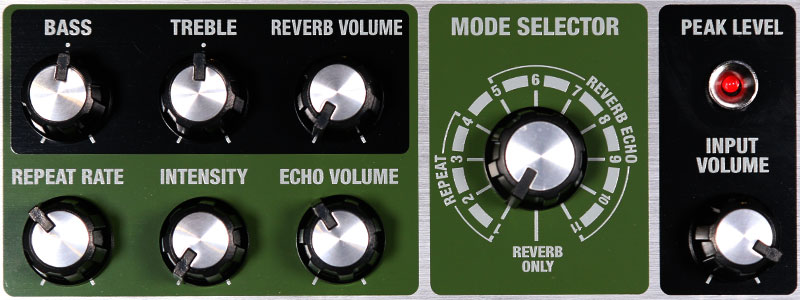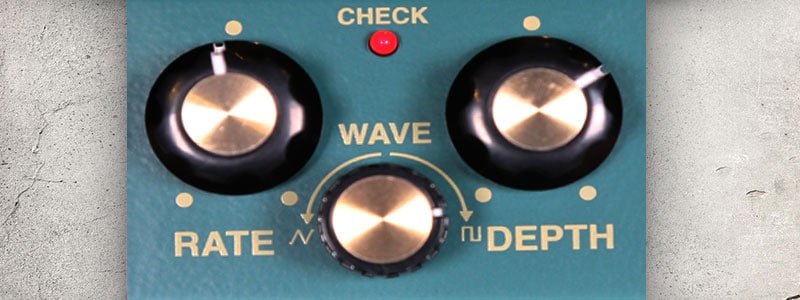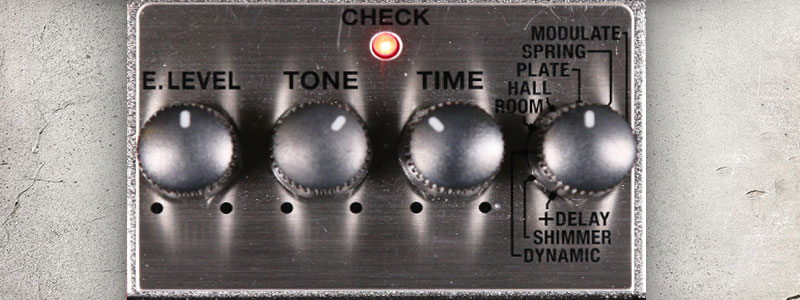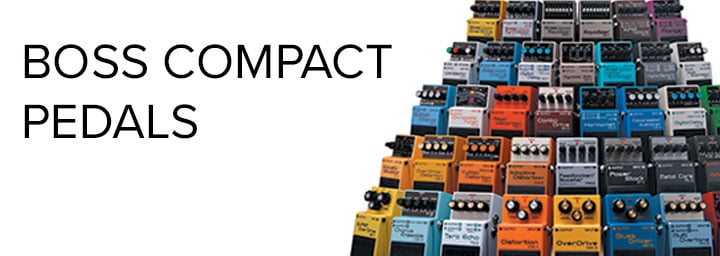The 1950s are probably the most crucial to Rock music. It was during the 1950s that Rock ‘n Roll became a cultural phenomenon, with truly trailblazing pioneers who fused Blues, Gospel, Jazz, Rhythm ‘n Blues and Country into a combustive new sound. The electric guitar became the predominant instrument of this new style of music, fundamental to the iconic songs of the era.
In this article, we’ll look at some of the key guitar tones of 1950s Rock ‘n Roll and explain how you can recreate them via BOSS pedals. Before we dive in though, it’s important to keep in mind that effects for the guitar in the 1950s were quite sparse!
A lot of the guitar sounds or effects that we associate with the 1950s came from production techniques or were built into amplifiers. Fortunately, BOSS pedals have the ability to recreate many of these sounds, providing you with legendary tones for 1950s inspired Rock ‘n Roll guitar music.
Contributed by Byron Struck for the Roland Australia Blog
SLAP IT
Rock ‘n Roll and Rockabilly guitar sounds of the 1950s can basically be summarised by one key term – slapback echo. Slapback echo is an effect that legendary record producer Sam Phillips used liberally during his Sun Studios recording sessions for artists such as Elvis Presley and his guitarist Scotty Moore. Phillips used slapback to add depth and more realism to a recording and it sounds great on guitar!
“Slapback echo” refers to a delay effect that has a short delay time (<100ms), a reasonably high effect level and (importantly) zero feedback (i.e. just a single delayed repeat).
Any BOSS delay pedal set with these parameters will be able to provide you with a slapback echo effect. To really nail that 50s vibe though, then your first choice might be the BOSS RE-20 Space Echo.
Slapback echo was originally produced in the 1950s using tape machines. As the BOSS RE-20 Space Echo accurately recreates the legendary Roland RE-201 tape echo machine, it is a fantastic choice for totally authentic slapback echo tones.
SUGGESTED SETTING:

[soundcloud url=”https://soundcloud.com/roland-australasia/re-20-space-echo” params=”color=ff5500&auto_play=false&hide_related=false&show_artwork=true&visual=false&show_comments=true&show_user=true&show_reposts=false” width=”100%” height=”166″ iframe=”true” /]
If the RE-20’s twin-pedal layout and in-depth controls are a little too much for your requirements however, then another great choice is the BOSS DM-2W Delay.
While this all-analog pedal is able to produce a wide range of delay and echo sounds from all eras of music, the DM-2W’s warm, all-analog design will give you a sound that’s much closer to the real analog tape echo machines that enjoyed use in the 1950s.
Either way, once you’ve got whichever BOSS delay you choose set to slapback, you’ll be ready to rock around the clock!
SUGGESTED SETTING:

[soundcloud url=”https://soundcloud.com/roland-australasia/dm-2w-delay” params=”color=ff5500&auto_play=false&hide_related=false&show_artwork=true&visual=false&show_comments=true&show_user=true&show_reposts=false” width=”100%” height=”166″ iframe=”true” /]
CLEAN GRIT
Distortion and overdrive weren’t really effects that were used by guitar players in the 1950s. The rougher, crunchier sounds heard on 50s Rock ‘n Roll/Rockabilly were produced by amplification, usually turned up loud.
BOSS’ SD-1W OverDrive will help “push” your guitar signal and your amplifier, so that the tone becomes warmer, similar to an old 50s tube amplifier on the verge of breakup. With options to add extra Drive and shape your sound via the Tone control, check out the SD-1W for killer 50s Rock ‘n Roll and Rockabilly tones – just like Eddie Cochran!
SUGGESTED SETTING:

[soundcloud url=”https://soundcloud.com/roland-australasia/sd-1w” params=”color=ff5500&auto_play=false&hide_related=false&show_artwork=true&visual=false&show_comments=true&show_user=true&show_reposts=false” width=”100%” height=”166″ iframe=”true” /]
For a grittier and more biting tone, then the BOSS BD-2W Blues Driver is for you. With a whopping amount of clean boost available to hit your amplifier via the Level control, plus additional Gain and Tone, the BOSS BD-2W Blues Driver provides authentic, rockin’ 50s tones!
Based on the original BD-2 Blues Driver and like the aforementioned SD-1W, the Waza version of this pedal takes the original design to a new level with all-discrete analog circuitry. You can even choose between Original or Custom (with additional body and sustain) via the Mode switch.
SUGGESTED SETTING:

[soundcloud url=”https://soundcloud.com/roland-australasia/bd-2w-blues-driver” params=”color=ff5500&auto_play=false&hide_related=false&show_artwork=true&visual=false&show_comments=true&show_user=true&show_reposts=false” width=”100%” height=”166″ iframe=”true” /]
ALL SHOOK UP
Tremolo is an effect that produces a kind of stuttering, chopping sound. Included on many guitar amplifiers in the 1950s, tremolo can be heard throughout many 50s Rock ‘n Roll/Rockabilly tracks, such as the legendary Rumble by Link Wray.
The BOSS TR-2 Tremolo takes the classic tremolo sound and puts it into a stompbox pedal form. With the ability to dial in twangy, vibing sounds heard throughout 50s Rock ‘n Roll/Rockabilly, the TR-2 is a perfect addition to your 50s-style setup.
SUGGESTED SETTING:

[soundcloud url=”https://soundcloud.com/roland-australasia/tr-2-tremolo” params=”color=ff5500&auto_play=false&hide_related=false&show_artwork=true&visual=false&show_comments=true&show_user=true&show_reposts=false” width=”100%” height=”166″ iframe=”true” /]
GIMME SOME SPACE
Reverb is all over 50s Rock ‘n Roll/Rockabilly. A naturally occurring effect, reverb in the 1950s was added to recordings by various methods. Some of these included recording in a water tank (like Duane Eddy), or using a spring reverb unit. Spring reverb is exactly what its name implies, the unit contains an actual spring for the sound to travel through, from which reflections and vibrations occur to replicate a sense of space.
An RV-6 Reverb from BOSS is an all-encompassing reverb pedal, with plenty of options to choose from. For authentic 1950s tones though, you’ll probably want to concentrate on the SPRING and PLATE modes.
The RV-6 SPRING mode creates the lo-fi, jangly kind of reverb that is associated with a guitar amplifier’s built-in spring reverb tank, complete with “sproingy” artifacts that can be heard when the amp and tank are cranked up.
PLATE mode recalls the huge reverb tones made famous in the late 50s and 60s by big, studio “plate reverb” machines.
You can also try out the ROOM and HALL modes, which can be used to recreate spaces similar to those heard on the 1950s Rock ‘n Roll/Rockabilly recordings, i.e. naturally occurring reverb.
SUGGESTED SETTING:
Spring Mode:

[soundcloud url=”https://soundcloud.com/roland-australasia/rv-6-reverb-spring” params=”color=ff5500&auto_play=false&hide_related=false&show_artwork=true&visual=false&show_comments=true&show_user=true&show_reposts=false” width=”100%” height=”166″ iframe=”true” /]
Plate Mode:

[soundcloud url=”https://soundcloud.com/roland-australasia/rv-6-reverb-plate” params=”color=ff5500&auto_play=false&hide_related=false&show_artwork=true&visual=false&show_comments=true&show_user=true&show_reposts=false” width=”100%” height=”166″ iframe=”true” /]
Related Articles
EVOLUTION OF THE ROLAND SPACE ECHO
ROLAND TALK EXCLUSIVELY WITH DAVID BOWIE PRODUCER, TONY VISCONTI
INSIDE A GUITAR AMPLIFIER – PART. 1
INSIDE A GUITAR AMPLIFIER – PART. 2
HOW TO ORDER YOUR EFFECTS CHAIN: IT’S EASY WITH MULTI EFFECTS
ECHOES IN TIME: THE HISTORY OF BOSS DELAY PEDALS
BOSS TALK: REVERB FOR GUITARISTS




